#White House Historical Association
Explore tagged Tumblr posts
Note
Hello!
Maybe to get our minds off this mess, do you have any fun pictures or lesser-known stories about the White House Pets and First Dogs (or Second Dogs. Champ FTW)?
Thank you!
I'm a big fan of President Ford's golden retriever, Liberty.

Here's an excerpt from a page about Liberty on the White House Historical Association's website, which tells you a lot about her and President Ford:
"Liberty quickly settled into life at the White House. She was often photographed outside, enjoying the South Lawn on sunny days. Liberty also enjoyed swimming in the pool at Camp David. At times, President Ford, allegedly used Liberty as a diversionary tactic in the Oval Office. When he wanted a meeting to end, he would signal to Liberty, who wagged her tail enthusiastically at the guest. This created a conversational break so the President could stand up, indicating the meeting had come to its conclusion. Liberty was part of the family at the White House, with President Ford frequently assisting with her care. At Ford's funeral in 2007, former White House Press Secretary David Nessen recalled that one day, Liberty 'made a mess' on the carpet in the Oval Office. A Navy steward started to clean it up, but President Ford stopped him, remarking that, 'no man should have to clean up after another man's dog.'"
That leads to a classic story about President Ford and a very pregnant Liberty getting locked out of the White House Residence in the middle of the night when the President took her outside to go to the bathroom. The Secret Service had to let him back inside.
#Presidents#History#Presidential History#White House#White House Pets#White House History#First Families#First Pets#First Dogs#Liberty#Gerald Ford#President Ford#Gerald R. Ford#Ford Family#Ford Administration#White House Historical Association
33 notes
·
View notes
Text
24 Days of La Fayette - Day 1
This year’s calendar will be about portraits of La Fayette, thanks to the idea of @my-deer-friend!
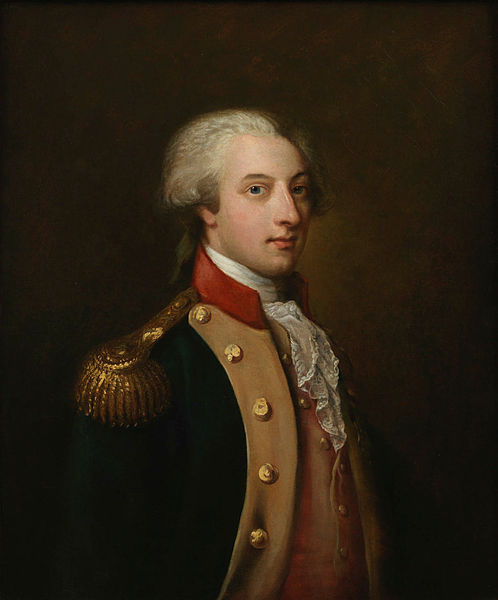
The portrait (1) hangs in the Blair House, just across the White House and Lafayette Square. The Blair House is often referred to as the President’s Guesthouse and is the accommodation for former US presidents and foreign dignitaries. The portrait hangs in the entrance hall and is the first piece of art that a visitor sees.To quote the White House Historical Association (2):
The framed piece hangs in the Entrance Hall of Blair House and is the first work of art guests observe upon entering the house. This is a fitting location for his painting since Lafayette was the nation’s guest and Blair House serves as the President’s guesthouse for today’s visiting heads of state.
The portrait is part of the collection of the White House Historical Association. The photographer who made the photo that is used today, was Bruce M. White for the White House Historical Association/Blair House. He also included the photo in his book “At Home in the President’s Neighborhood: a Photographic Tour”. According to the digital Library of the White House Historical Association, both the date when the piece was painted, and the artist are unknown. It has been in the possession of the White House Historical Association and hangs in the Blaire House since at least 2016.
This piece is one of my personal favourites and some of long-term followers of this blog might remember that this portrait was for a very long time my profile picture – that’s why we start our calendar with the portrait that is today known as The Nation’s Guest. It is subtle, almost calming, and, at least from my point of view, quite a good representation of La Fayette. There is not much in terms of politics or symbolism going on as with many other of La Fayette portraits. He simply sits there and looks the viewer straight into the eyes. He is still young but without looking like a little boy - for me the portrait is simply the perfect combination of many different elements.
(1) https://library.whitehousehistory.org/fotoweb/archives/5017-Digital-Library/Main%20Index/Blair%20House/1113205.jpg.info (01/12/2023)
(2) https://www.whitehousehistory.org/photos/the-nations-guest-photo-1 (12/01/2023)
#24 days of la fayette#advent calender#my-deer-friend#marquis de lafayette#la fayette#french history#american history#history#art#white house historical association#blair house#bruce m white#the nation's guest
40 notes
·
View notes
Text
“U.S. President Joe Biden issued a memorandum on Thursday requiring allies who receive military aid from the U.S. to provide ‘credible and reliable written assurances’ of their adherence to international law including international human rights law,” the Times of Israel reported. Israel will need to supply written assurances within 45 days or risk loss of aid. The report added, “The memo did not mention specific countries who would be held up to the new standard, but came amid increasing calls in the U.S. to condition aid to Israel due to concerns over its military operations in Gaza which were triggered by the Oct. 7 attacks, in which Hamas terrorists murdered some 1,200 people, mostly civilians, and kidnapped 253.” No one should underestimate the impact of the decision. The Associated Press explained, “Democratic senators on Friday called Biden’s directive — meant to bring breadth, oversight, deadlines and teeth to efforts to ensure foreign governments don’t use U.S. military aid against civilians — historic.”
[.......]
Biden also pressed on with intense one-on-one diplomacy. After his comment on Thursday evening that Israel had been “over the top” in Gaza, Biden engaged with Netanyahu on Sunday in a 45-minute conversation — unusually long by most diplomatic standards (and even more so given that no time had to be spent on translation with English-fluent Netanyahu). According to the White House readout, Biden insisted Israel make “credible” arrangements to protect civilians before launching a widely criticized military plan for Rafah, where civilian casualties could mount. He also pressed Netanyahu again to increase humanitarian aid to the Palestinians. Biden’s patient approach with Netanyahu over months has gradually transformed into a private and public pressure campaign. A Biden official told The Post that the leaders had “a pretty detailed back and forth on that.”
-- Biden delivers tough love, takes historic step: Conditioning aid to Israel
Meanwhile Trump?
Trump has said he would implement travel bans on people from certain countries or with certain ideologies, expanding on a policy upheld by the Supreme Court in 2018. Trump previewed some parts of the world that could be subjected to a renewed travel ban in a mid-October speech, pledging to restrict people from the Gaza Strip, Libya, Somalia, Syria, Yemen and "anywhere else that threatens our security." During the speech, Trump focused on the conflict in Gaza, saying he would bar the entry of immigrants who support the Islamist militant group Hamas and send deportation officers to pro-Hamas protests.
Also: Trump vows to expand Muslim ban and bar Gaza refugees if he wins presidency
Really, really not sure how much clearer I can make it here for y'all, but sure. Something something Trump's actually a better choice on this issue/overall (sarcasm).
#politics for ts#israel hamas war#i mean#i know this argument is nonsense#but sometimes you look at it and feel compelled to point out just how much nonsense it is
2K notes
·
View notes
Text
President Joe Biden is commuting the sentences of roughly 1,500 people who were released from prison and placed on home confinement during the coronavirus pandemic and is pardoning 39 Americans convicted of nonviolent crimes. It's the largest single-day act of clemency in modern history. The commutations announced Thursday are for people who have served out home confinement sentences for at least one year after they were released. Prisons were uniquely bad for spreading the virus and some inmates were released in part to stop the spread. At one point, 1 in 5 prisoners had COVID-19, according to a tally kept by The Associated Press. [...] The clemency follows a broad pardon for his son Hunter, who was prosecuted for gun and tax crimes. Biden is under pressure from advocacy groups to pardon broad swaths of people, including those on federal death row, before the Trump administration takes over in January. He’s also weighing whether to issue preemptive pardons to those who investigated Trump’s effort to overturn the results of the 2020 presidential election and are facing possible retribution when he takes office. Those pardoned Thursday had been convicted of nonviolent crimes such as drug offenses and turned their lives around, White House lawyers said. They include a woman who led emergency response teams during natural disasters; a church deacon who has worked as an addiction counselor and youth counselor; a doctoral student in molecular biosciences; and a decorated military veteran. [...] Rep. Jim McGovern, D-Mass., and 34 other lawmakers are urging the president to pardon environmental and human rights lawyer Steven Donziger, who was imprisoned or under house arrest for three years because of a contempt of court charge related to his work representing Indigenous farmers in a lawsuit against Chevron. Others are advocating for Biden to commute the sentences of federal death row prisoners. His attorney general, Merrick Garland, paused federal executions. Biden had said on the campaign trail in 2020 that he wanted to end the death penalty but he never did, and now, with Trump coming back into office, it’s likely executions will resume. During his first term, Trump presided over an unprecedented number of federal executions, carried out during the height of the pandemic.
194 notes
·
View notes
Text
more queer houses!
Klovharu Summer Cottage by Raili Pietilä for Tove Jansson and Tuulikki Pietilä
1964-1965, Klovharu Island, Porvoo Archipelago, Finland
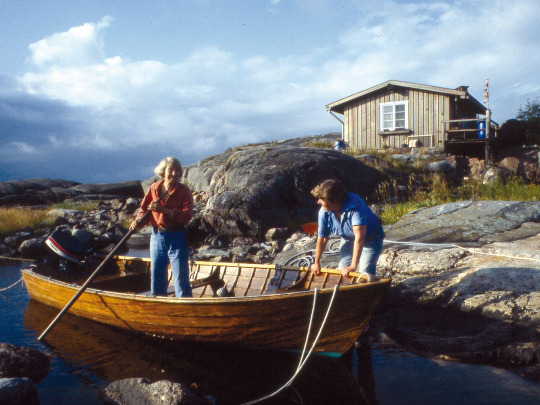
Tove Jansson and Tuulikki Pietilä spent every summer in this cottage for nearly 30 years. Tove chose the site by camping on various places on Klovharu, and they designed it with Tuulikki's sister-in-law, based on a fisherman's cabin on the island of Pellinge. It lacked electricity and running water, and if guests arrived, Tove and Tuulikki would give up the bed and camp outside. the cottage is a single room, with a cellar underneath--for food storage and a small sauna--built into the rock. the cottage is now an artist residency--with the original interiors preserved--but can be visited during one week in July. More about the cottage. Interview with Raili Pietilä. Tuulikki's films.
Hangover House by William Alexander Levy for Richard Haliburton
1937, Laguna Beach, California, USA
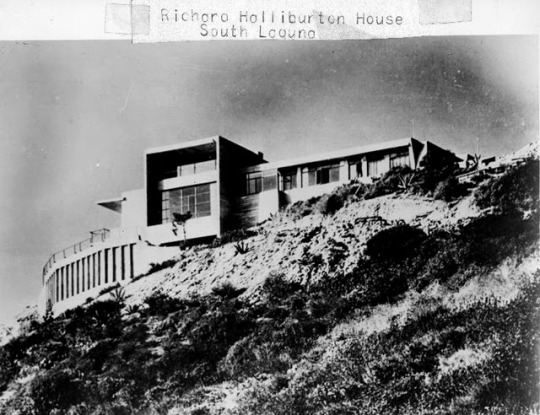
Hangover House, or Halliburton House, was designed by William Alexander Levy (he later dropped Levy from his name) for celebrity explorer Richard Halliburton and his ghostwriter and lover Paul Mooney. Supposedly, by the time the house was completed Halliburton and Mooney's relationship had expanded to include a third: Alexander himself. The house was built of concrete, with large public rooms and three small bedrooms, one for each of the men. Sadly, Halliburton and Mooney were lost at sea in 1939, and Halliburton's family sold the house and buried all references to his queerness. The house still stands today and is a private residence. More images here.
Azurest South by Amaza Lee Meredith 1938, Ettrick, Virginia, USA
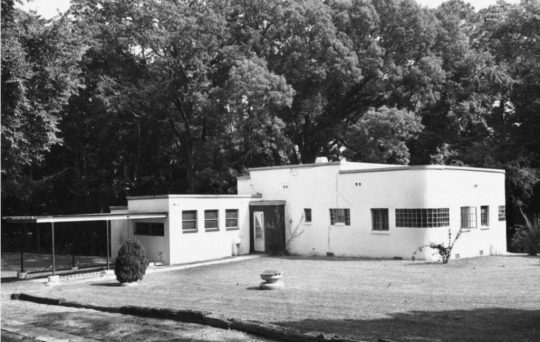
Azurest South might be the first International Style home to have been built in Virginia, and instead of in a wealthy white enclave like you might expect, it's located just off of the campus of Virginia State University, an Historic Black College/University. it was built by pioneering artist, architect, and educator Amaza Lee Meredith for herself and her partner, Dr. Edna Meade Colson. colson was the head of the education department at VSU, and meredith was head of the art department (which she had created in 1930). we know from her scrapbooks that meredith was looking at european designs and experimenting with them in the house. the result was something unlike everything around it--flat roofs, glass bricks, bright paint and tilework inside--an antidote to traditionally conservative virginia architecture. azurest south today belongs to the vsu alumni association. it is not open to visit, but has received increased attention and grant funding over the past few years, so it may well be someday! More about Meredith as architect. More about Azurest South. And more! (additionally, if you're near richmond va there's an exhibition about meredith & azurest south at the institute for contemporary art until march 9 2025)
Six Acres by Mary Imrie and Jean Wallbridge 1954-1957, Edmonton, Alberta, Canada

Mary Imrie and Jean Wallbridge were partners in work and life, establishing the first all-female architectural firm in Canada. in the 50s, they built a house to serve as their home and office along the banks of the north saskatchewan river and called it "six acres" after the size of the lot. they traveled enthusiastically and widely (pdf) and were avid outdoorspeople. like a lot of women architects at this point in the 20th century, they were largely relegated to residential commissions, which they found frustrating. that said, they gained a reputation for helping clients who were struggling with construction costs by encouraging gatherings of friends and neighbors to assist with the work, something they had hands-on experience with, having assisted in the building of their own home. the house is still standing and is now the office of the alberta land stewardship centre. timeline of their lives and careers. more about the house itself.
Finella by Raymond McGrath for Mansfield Duval Forbes c. 1850, renovated 1929, Cambridge, England, UK
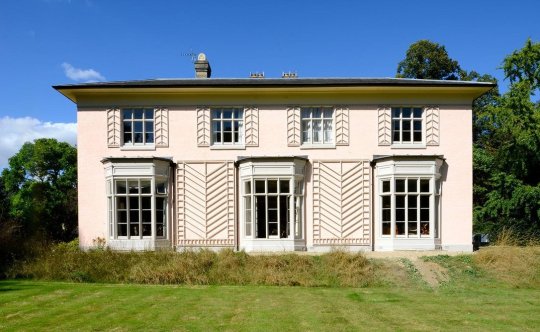
Mansfield Forbes was an english don at clare college, cambridge. in 1928 he leased a victorian home called "the yews" and spent the next year working with Raymond McGrath (previous seen here) to transform it into a modern fairyland, named in tribute of Finella, a 10th century Pictish queen. the interiors were a celebration of new materials--there were floors made of induroleum (wood and asbestos powder), walls painted with iridescent cellulose paint, something called copper plymax (??), and the entry hall had a vaulted ceiling covered in glass panels backed with silver leaf. forbes intended it to be a gathering place of sympathetic minds, to host salons in celebration of modern art and architecture in a setting a queer and future-looking as he himself was. unfortunately, he vastly overspent in outfitting Finella, and when he died suddenly in 1935, the contents of the house were auctioned off. Finella is still part of Cambridge and houses fellows of gonville & caius college. the college recently restored the hall, which can apparently be toured on specific days. interior photos from 1929 and 2004.
112 Charles Street by Eleanor Raymond 1868, renovated 1922, Boston, Massachusetts, USA
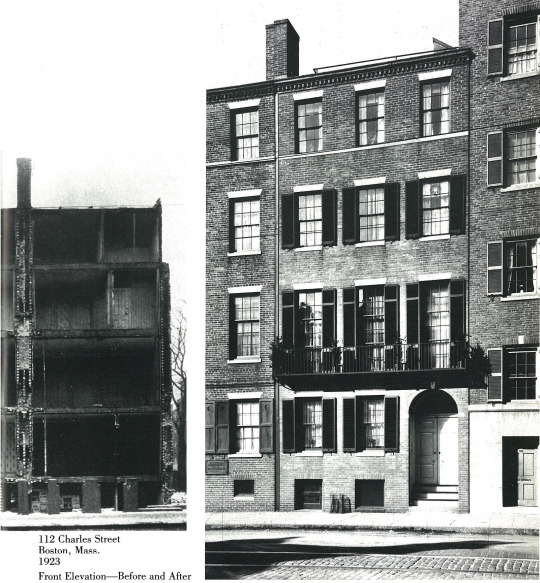
When Eleanor Raymond began work on 112 Charles Street, it had recently had the front 10 feet sliced off to allow for the widening of the street, so her renovation was essentially a reimagining. eleanor designed the house for her mother, who had her own apartment, as well as eleanor herself, her sister rachel, and her partner ethel powers. the three of them shared a floor. powers wrote for the magazine House Beautiful (and would go on to be its editor) and featured the home three times. in the largest feature on its interiors, she emphasized that since it was a home of three business women, it needed to be "self running." raymond would go on to design and build much more modernist houses, and the conservative appearance of this one might be due to how early in her career it was (she graduated from her architecture program in 1919), but i think it's more likely that she was aware of the necessity of appearing somewhat inconspicuous in her surroundings, as a queer woman with a career. read more about her work here. and here.
#queer architecture#long post#most of my sources are the things i linked to with the exception of finella#finella i learned about from an article in the journal of british studies#she also authored the chapter about it in the book 'Queer Spaces'#happy to send the article along to any interested parties#hangover house i read about in a different article which i can also hunt up if requested
129 notes
·
View notes
Text
The day after Minnesota Governor Tim Walz was announced as Kamala Harris’s choice for vice president, Senate Majority Leader Mitch McConnell told a crowd of lawmakers in Louisville, Kentucky, that a Harris administration would spell certain doom for the Republican Party. “Let’s assume our worst nightmare—the Democrats went to the White House, the House, the Senate,” McConnell said during his keynote speech at the National Conference of State Legislators Legislative Summit last week, according to Spectrum News. “The first thing they’ll do is get rid of the [Senate] filibuster. Second, you’ll have two new states: D.C., Puerto Rico. That’s four new Democratic senators in perpetuity.”

Puerto Rico will vote on a nonbinding ballot measure in November to determine the territory’s future political status, with voters being given three options, all of which would change its official status: statehood, independence, or independence with free association. It will be the seventh time that the island’s 3.2 million people vote to define their political relationship with the United States. Harris has not yet taken an official stance on the vote.
McConnell insisted that next on the historically moderate Democrat’s agenda would be to place as many liberal justices on the Supreme Court as possible, noting that doing so would be “unconstitutional”—while apparently ignoring the fact that that’s exactly what Donald Trump did to achieve SCOTUS’s current conservative supermajority.
“If they get those two new states and pack the Supreme Court, they’ll get what they want,” McConnell said.
Ultimately, McConnell believes that the Harris-Walz ticket “represents the far left of the Democratic Party.
“And by the way, that’s most Democrats today,” he added.
Following the address, Kentucky Senate President Robert Stivers broke down the Republican perspective on why Harris turned to Walz as her right hand.
“They’re trying to appeal to a rural voter that they have not appealed to in years,” Stivers said, reported Spectrum. “Now, whether they can or they can’t, that becomes a good question, and I think that will be based on the policies that they put forward. And hopefully, that’s what we get into.”
206 notes
·
View notes
Text



── 𝐑𝐎𝐀𝐃𝐊𝐈𝐋𝐋 // 𝐏𝐑𝐎𝐋𝐎𝐆𝐔𝐄

Series Synopsis: You were once a spoiled duchess-to-be, set to inherit a city on the brink of a war you knew nothing about — that is, until the war came to your doorstep and the aftermath of a brutal accident bound your fate to Seishiro Nagi’s forever.
Chapter Synopsis: Nagi comes bearing news. // Your father makes an announcement about the new family in Maradine.

Series Masterlist
Pairing(s): Nagi x Reader, Yukimiya x Reader
Chapter Word Count: 2.3k
Content Warnings: death, killing, ptsd, reader is not a good person, actually nobody really is??, they all make mistakes as is to be expected, war is mentioned and the build-up/aftermath is discussed heavily but the actual conflict not so much, non-linear narrative, like HEAVILY non-linear there are two timelines for each chapter (pre and post war), probably ooc, angst, nagi is endgame sorry y’all, alternate universe (early 1900s-ish vibe but not in our world because f historical accuracy), original characters (probably…idrk yet but it’s me so)

A/N: hey guys…so here i am…with the prologue to a new story instead of an update to anything i already have out BYE I’M FLEEING FROM SHAME i’ve been wanting to do something a bit more serious for a while though so i’m excited to give this a try!! some more elaboration on the tags/summary: this is like vaguely historical-ish but not completely, and it’s kind of like two stories being told concurrently?? one being reader’s life as an adult post war and the other her life as a child/teen pre war. every time there’s a ‘break’ in the chapter that indicates a timeline switch!! hopefully it’s kinda obvious which is which especially as we go along…anyways hope you all enjoy

“Kenyu Yukimiya is dead,” Nagi said. Medals sparkled against his breast, the gold a harsh contrast to the dark wool of his coat, and his arms were folded behind his back, which he kept ramrod straight, so unlike the slouch you once associated with him. “They thought it would be best if I were the one to inform you.”
He waited for you to say something, looking much like a mannequin all the while, his pale hair lifeless, his driftwood eyes dull and blank. His careful mouth was pursed into a plain expression which might be considered a frown on another person, but not on him. Never on him. After all, Nagi did not frown. Nagi did not smile. Nagi did nothing.
“It should’ve been you,” you said.
“Yes,” he said, as prompt and detached as always. “It should’ve.”

Barlezia was a sweeping country, and perhaps you were biased in saying so, but there were none in the world that could claim to be its equal. In the north there were towering mountains which scraped at icy skies, a heavy blue-grey fog settled over their peaks, and to the south there was a vast sea, warm and aquamarine, which led to Drieji in the east and Abraria in the west.
It was on this sea, the Canonora, that the shining city of Maradine was located. Far enough from the northern capital of the nation to have taken on its own character, its own wealth, Maradine was the jewel of Barlezia, a place full of men with horses and women with parasols. Built upon a slate cliff, with houses lining the roads winding down to the pebbly sand, it jutted so far out into the water that some people spent their entire lives on their boats, only venturing onto land for the rare storms that might otherwise drown them.
Near the top of the cliff, where the marble government buildings were sequestered away from the rest of the city, there was a villa. It was the largest of its kind, the walls a deep red terracotta trimmed with white, the floors all glazed porcelain, the many colors and shapes painted onto the tiles making up larger designs of flowers, animals, and other such wonders. The villa overlooked the ocean and a canopy of trees, and it was widely regarded in all of Maradine as the most beautiful in that most beautiful of places, the filigree on an already intricate crown, the diamond in a choker of gold.
This was the villa where you were born, and this was the villa where you would, you presumed, die. Some forefather of yours had constructed it in a time where such art had been celebrated, where Barlezia had ruled the world, and it remained as a remnant of that age, a stronghold against modernity, even though your country had long ago bowed in deference to the ideals and traditions of those in the west.
“Child! Get down from there!”
The woman that took care of you in lieu of your parents, who were often busy — your father with his politics, your mother with her parties — was slender and frail and too old for keeping up with anyone with any measure of youth. Her hair was entirely grey, and her face was perpetually lined, with sun, with shade, with age and wisdom and worry. You knew her simply as Nanny, and as she was the only one who ever had the courage to chastise you, you found you disliked her very much.
“My tenth birthday is approaching, so you ought not to call me a child any longer,” you said, your legs swinging from your perch in the boughs of a fig tree, the collar of your neatly-pressed dress splotched dark with the juice of the fruit you held in your hands.
“If you continue to behave like this, I certainly will!” she said, her hands on her hips. “Shall I call the manservant?”
The manservant was willful and rough; you doubted he would have any qualms about dragging you to the ground with his bare hands, were he so inclined. Taking one last bite out of the fig, you threw it to the ground, where it burst at Nanny’s feet, and then you clambered out of the tree with as much grace as you could muster.
“You horrid creature,” she hissed at you when you smiled at her, your skirt wrinkled and torn at the hem, your fingers sticky and purple. “How am I to present you to your father and mother in this state?”
“How you always present me, I expect,” you said, batting your eyelashes at her, skipping lightly towards the door. “With more fuss than required.”
She grabbed you by the ear before you could get very far, yanking it sternly, earning a howl out of you. Stomping your foot, you glared at her and waited for her to let go, which she only did when she was assured you would not flee again.
“I will send along a message that you will be late to breakfast. To your room, missy, I won’t have it thought that the young duchess is some mannerless, ill-behaved ruffian,” she said, ushering you towards your quarters as if you were a sordid secret.
“Maybe you need to be better about watching me, and then my manners will improve,” you said, and because you were not doing anything untoward, only saying it, the most she could respond with was an exaggerated sigh.
She bathed you for the second time that morning, quicker than the first, and then she dressed you in something without pattern or finery. Certainly it must’ve pained her, for the ruined dress balled up and thrown into a wastebasket had been much prettier than this one, but there was nothing she could do about it, bar glaring at you as she yanked it over your head.
Nanny wasn’t always so foul-tempered; it was only when you tried her patience, as you did today, that she got to be in such a mood. Else she was a tolerable woman, if not a kind one, and generally softer with her motions. She had mentioned to you a long time ago that she had children of her own, two daughters and a son, the youngest of whom was closer to your mother’s age than your own. You supposed it meant she had some experience with child-rearing, hence why your parents had chosen her amongst the many applicants, and you sometimes wondered if she had treated her own progeny the way she treated you.
Once, you had asked her. She had told you, with a click of her tongue, that she was far stricter with them; however, as you could not fathom anything more chafing than her treatment of you, you found it hard to believe.
Although you were older now — nearly ten years of age, as you liked to remind everyone — you were still not considered enough of an adult to eat with your parents and the rest of adults at meals. Instead you would sit in your room and make faces if the food was not to your liking, discreetly glancing at Nanny out of the corner of your eye and throwing away what you couldn’t stand when you were sure she was not looking. The exception was meals which were meant to be occasions or announcements, wherein your presence was absolutely and unquestionably required.
Today was an announcement, not an occasion, or at least that was what Nanny told you. You did not know the nature of the announcement, only that she was more nervous than usual as the two of you walked to the breakfast room, where your parents would be waiting for you. Up until then, you had been convinced that she had only had two modes of being — fed-up and obedient — so the discovery of this third intrigued you far more than whatever news you might be given.
“Nanny,” your father said. “Y/N. Good morning.”
He did not comment on your tardiness, and neither did he have to; his disapproval was the silent type, which radiated into the air and shimmered like steam, cowing in its intangibility. Your mother offered you a half-smile, as trained and perfect as yours one day would be, and you smiled back at her, your entire focus going into ensuring it was not crooked.
“Good morning, father, mother,” you said, settling into the large chair at your mother’s right, your feet just barely brushing the floor when you were settled with your spine to the cushioned back. “I apologize for the delay.”
“It is inconsequential,” your father said, which was as much of a reprimand as you’d ever get out of him. “We have more important matters to discuss now that you are finally here.”
“There is to be a party,” your mother said. This was nothing out of the ordinary, for your mother, as the Duchess of Maradine, was invited to every party that could be reached from the villa in less than a day. What was strange was that both she and your father thought that you needed to be informed of this occurrence.
“I see,” you said.
“It’s that family from Aprissari,” your father said, sneering at the mention of Barlezia’s capital, the city nestled in the mountains to the north of the country, which may have been the center of your nation’s power but was nowhere near as prosperous as Maradine, never had been and never would be. “The Yukimiyas. The wife is an opera singer and the husband is far more involved in foreign affairs than he has any right to be.”
“And they are rich,” your mother said, patiently and coolly. “Richer than mere commoners. Rich enough to be considered members of the nobility, if we are not careful.”
“We must build proper relations. An alliance, so to speak, but also a reminder that they are no longer in Aprissari,” your father said. “It must be clear to them and to everyone that in Maradine, their money is meaningless if they do not have the approval of the L/N family.”
“Their son is only a little older than you,” your mother continued, perhaps noticing that you no longer held much interest in the conversation, which had diverted to topics of which you had little understanding and even less interest. “The party is being held in honor of his twelfth birthday, and you are to befriend him as best you can.”
“It won’t be difficult,” your father said, and the reluctance of his conviction was the first clue you had that the arrival of these Yukimiyas meant something more to your family than you could possibly know. “You are Y/N L/N; there’s not a child this side of the country that wouldn’t want to be your friend. But you must do it.”
If Nanny or the manservant or anyone else in the L/Ns’ employ told you something so harshly, you would’ve protested or found some way around it, but this was not anyone else. This was your father, Duke L/N himself, and so it was as much a royal command as it was a request from someone who loved you. Perhaps it was even more the former than it was the latter; based on the wideness of your father’s eyes and the lowering of your mother’s lashes, you wouldn’t be surprised if it was the case.
“Yes, father,” you said. “I shall do as you say.”
“Good,” he said. “Finish eating and then attend your lessons as usual. We shall leave once the sun sets.”
You ate at a record pace. Your parents were exchanging looks that said they wanted to speak to one another alone, and it was only your presence which was hindering them, so you endeavored to make yourself scarce as fast as you could without seeming rude.
Excusing yourself quietly, your head bowed until you left the room, you followed Nanny towards your chambers, deep in thought, turning over the directive your parents had left you with. Befriending the son of the Yukimiyas. For you, who had never had a friend your own age, it was more difficult of a task than your parents must’ve anticipated, so with a tug on the end of Nanny’s apron, you halted in your tracks.
“You heard my father, right, Nanny?” you said. “I have to befriend that boy.”
“That you do,” Nanny said, and then there was a fourth aspect to her which you unlocked: sympathy, glimmering in her irises like a sunrise on the crest of a wave.
“I don’t know how to do that,” you said. She patted you on the head, brusque and perfunctory, like she was dusting flour off of her hands, yet somehow affectionate, in her way.
“You’ll have to learn, missy,” she said. “Ties with the Yukimiyas may be invaluable in the years to come.”
“Whatever do you mean?” you said. She placed one hand against the wall, her thumb tracing an idle circle over it as she contemplated something or another.
“There are as many ideas of what’ll happen to the continent as there are fish in the Canonora Sea,” she said. “Whether by will or force, Barlezia shall, like every other nation, choose which they back. If they choose wrong, then Maradine will bear the brunt of the consequences. That is all.”
“But what do the Yukimiyas have to do with it?” you insisted.
“Nothing and everything, child! You will understand when you are older. Now hush and go to your lessons,” she said, breaking from her trance and pushing you into your room, where one or another of your tutors would, invariably, be waiting for you.
You wanted to rail at her, to tell her that you weren’t too young, that you deserved to know as well as she did what might yet happen to your own city. Before you could say anything more, however, she shut the door behind you, leaving you standing alone by the wastebasket, where a rusty stain the color of fig juice continued to spread down the sleeve of your crumpled dress.

#nagi x reader#nagi x y/n#nagi x you#nagi seishiro#yukimiya x reader#yukimiya x y/n#yukimiya x you#yukimiya kenyu#bllk x reader#bllk#blue lock#reader insert#historical au#fantasy au#roadkill#m1ckeyb3rry writes
89 notes
·
View notes
Text
Trafalgar Law and Faith
Pre-emptive warning this is going to be another LONG metapost/analysis. There’s a lot I could talk about here but for the sake of structure I’m going to split this into three sections, i.e. the main ‘faith transitions’ that Law has gone through in the narrative thus far: 1. Flevance (catalyst for loss of religious faith), 2. Corasan (martyr that figuratively and literally saves law by giving him something to live for, introducing the will of D.), and 3. Luffy (cementing faith in this new belief system and regaining trust in the goodness of humanity through the living embodiment of everything Corasan believed in).
Before we get into all that though, let’s establish that Christianity is a thing in one piece. Speedrunning through some visual examples that come to mind; the Flevance church and nun (holding a celtic cross - censored in the anime version), a nun literally praying to God right before Marineford, Vinsmoke Sora’s grave marked with a cross (is op Christianity a northern thing?), Usopp and Chopper having crucifixes and holy water whenever ghostly stuff is brought up, Kuma and his trusty bible, the religious symbols on Kikoku’s hilt (could instead be more a reference to the Red Cross/symbol of humanitarian and medical aid as a doctor) and especially in whatever Mihawk’s got going on (though this could just be a Japanese cultural thing with Christianity being a minority religion or Oda just finding that some of the iconography, y’know. looks cool). There are also many other references to other religions e.g. hinduism, shintoism, buddhism, etc. Whether op forms of religion are the same as the real-world ones is debatable, and yes, Law being canonically raised as a devout catholic schoolboy with all the religious trauma associated with that is comical, but let’s take it all unironically for a hot minute. For fun.
1. Flevance
Law’s birthplace (Flevance) is described as being, at one point, “a very wealthy country with an unearthly beauty about it, with pure white soil and plants, like some kind of snow kingdom in a fairy tale.” The country’s wealth came from the very bedrock it sits on — white lead, which could be used to make various high quality products like tableware, cosmetics, weapons etc. When the wider world heard about this everyone wanted a piece of Flevance (the World Government also getting involved with distribution), and very quickly white lead became a “bottomless well of money”. So, hooray. Law gets to grow up in a rich city in a big house with educated doctor parents and probably gets to go to private school on weekdays and festivals with his family on weekends. One problem. In their greed, the Government and royalty have been knowingly hiding the truth about this supposed goldmine from the beginning. White lead is a toxic poison. Mining it from the ground over the last century and putting it in so many everyday products has resulted in it accumulating in the citizens’ bodies and leading to amber lead sickness, shortening their life-span with each successive generation – with the children of Law’s generation fated to die out before they reach adulthood.
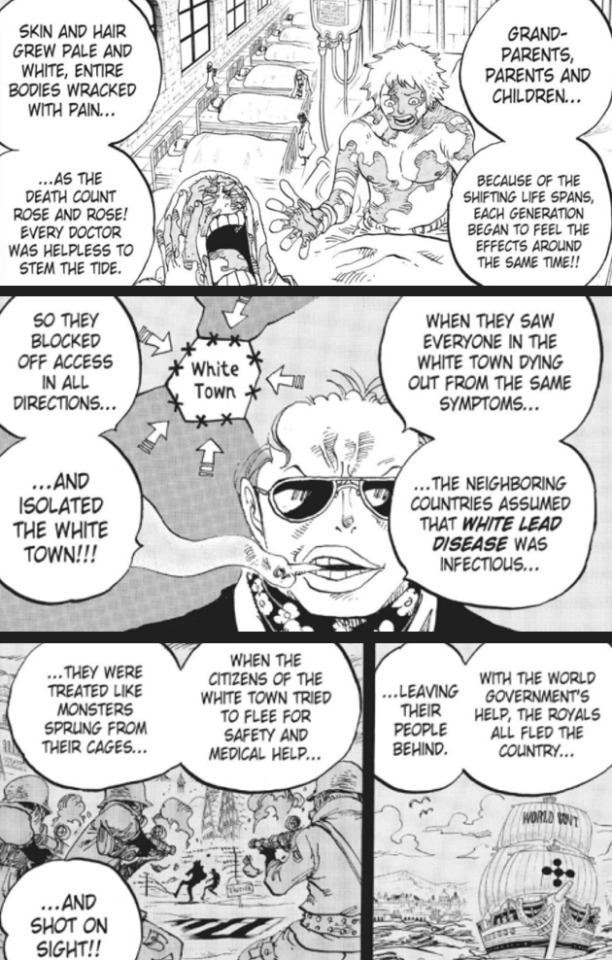
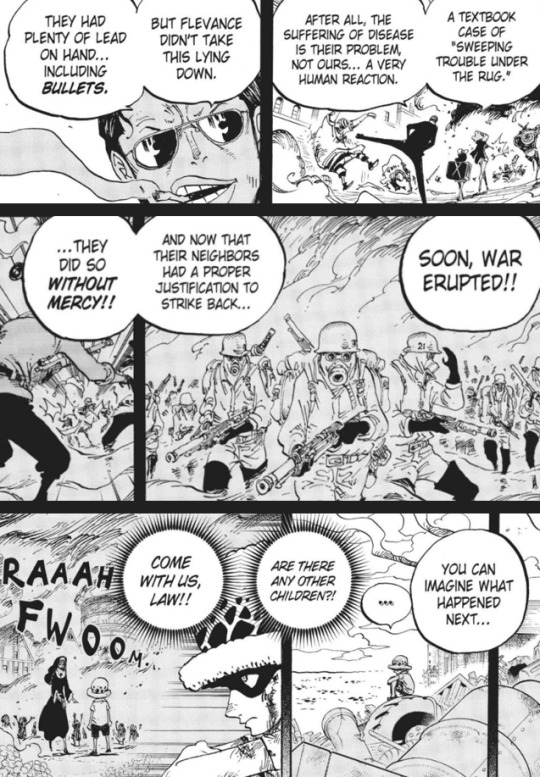
In the bible (especially in the old testament), God often inflicted these insanely disastrous events upon humanity, usually as some kind of punishment for their wrongdoings or as a test of their faith. Some events of which include (but are not limited to): famine, outbreaks of disease and natural disasters (e.g. hail, wildfire, earthquakes, floods). Historically, these stories played a key role in how humanity interpreted meaning from horrible disasters (e.g. assuming bubonic plague was sent as a punishment by god). Fire imagery is very common among these disasters as a representation for hell, which is clearly reflected in the destruction of Flevance.
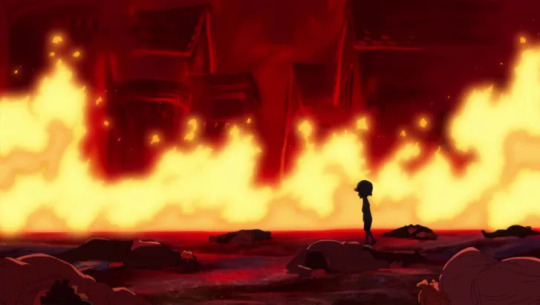

Sometimes these disasters had sole survivors act as messengers for God. With that context, let’s put ourselves back in the shoes of a ten-year old Law. Raised religious, freshly traumatised from losing his home, his devout family, all the comforts of his life, and having the outside world completely abandon him, this kind of event is likely going to be processed as some form of divine punishment. Law stumbles through hell, finds all his dead classmates, and the last words of sister nun echo through to him here. Merciful and salvation are huge catholic buzzwords – promises of holy compassion, deliverance and hope – and all of it fire and smoke and riddled with bullet holes before him. A genocide funded, perpetuated and covered up by the same body Law was promised was there to save them. And the only reason Law hadn’t died with them was because he wanted to stay with his little sister Lami, who was on her deathbed, and his parents, who were themselves trying to help the afflicted citizens, Law’s own father (before he was shot and killed alongside his mother) begging for more doctors, fresh blood, anything the world can offer, and asking “Why doesn’t the government announce to everyone that white lead is not infectious?”
Oftentimes (and in the case of Law), when there’s a promise of heavenly intervention or some miracle that doesn’t follow through, it results in an ultimate feeling of betrayal and anger. Unfortunately a lot of Catholic teachings also use a lot of guilt, essentially teaching people that the bad things that happen to you are your fault and there needs to be some sort of penance (queue Law’s survivor’s guilt that carries on down the road). But also, if this was supposed to be some divine punishment, for what exactly? For the town being blinded by the incredible wealth they were sitting on? Being lied to? Continuing to extract their livelihood, ignorant of its dangers? Punishment for who? His parents? His innocent little sister? For ten year-old Law? These people who believed in God, who were good people? That’s fucking stupid. None of these people suffered and died for any reason at all — certainly not for a sacred one. God hadn’t saved a single one of them. Law had to crawl out of hell himself by sneaking over the border under a mound of corpses.
Given everything that happened here, Law has every reason to fall into nihilism, and you can see how his upbringing would’ve bred a lot of the feelings of guilt, anger and resentment that you still see in Law (which would suggest that though this is where he likely cuts ties with the religious/Catholic component of his faith, growing up with these teachings in his formative years would definitely influence underlying beliefs about how the world works, and how Law behaves and subconsciously processes information), but at the same time, there’s usually some form of redemption and changes to how these patterns of behaviour can be approached later down the line.
2. Corasan
Fresh off witnessing his whole world burning down around him, Law meets Corazon at the very bottom of this pit of self-destructive rage and unprocessed grief. Rosinante himself mentions to Sengoku that the hatred in Law at this time reminded him of his brother, but beyond the anger, harsh pessimism, vengefulness, I think you have to reach to find similarities between them. You can see some fragments of Doffy in Law down the line at times, with Law seeming to enjoy violence (especially against the navy, but given what they did to Flevance, it’s some well-deserved retribution for Law imo), but I’m not so sure it’s the cruelty so much as it is the high he gets off his own flavour of justice. Doctor’s Hippocratic oath maybe, but never once does Law like seeing others die (even at this point, he’s in tears next to a dead body, even though he’s the one holding the knife), and later on in Wano he makes it explicitly clear to Zoro that he’d rather see the mission fail than have any of them end up dead.
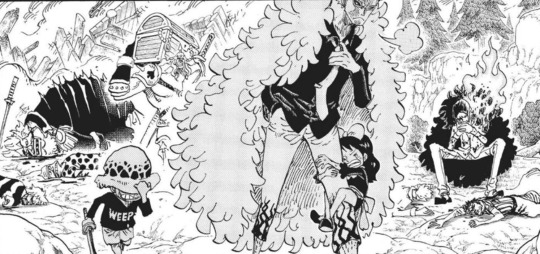
Little Law wanted to destroy the world and everything in it, but thinking rationally, what other choice did this kid have? He had no remaining family, was doomed to die before he hit puberty due to a terminal illness, was perceived as an infectious subhuman that most doctors would’ve sooner tried to exterminate than help. To Law, the world had turned its back on him – considering him a monster for simply surviving. He has all this hatred and pain boiling away with him with no tangible target to direct it towards. And this is the first clear cut rejection of faith that we see in Law. Any concept of a merciful God had just died. What God would allow this? Why is Law alive (a question that he repeats to himself throughout his life), why are these scumbags alive, why is the world going on spinning as if nothing has happened when his whole world had gone up in flames, why does anyone at all get to be here when everything I loved is gone? And it’s far easier to fall into a despondent nihilistic stupor than it is to work through any of that, and what’s the point in trying to process and move on from it, when there’s no hope for a future for Law anyway? When the only thing waiting ahead is more pain? What was this, if not a punishment? He’s supposed to be some messenger for God? How about fuck God, or whatever entity that exists that made him suffer this. Law’s not going to be a messenger for shit, thanks, he’d rather be their monster, he’d rather watch the world burn.
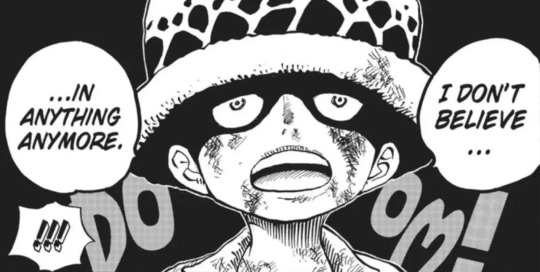
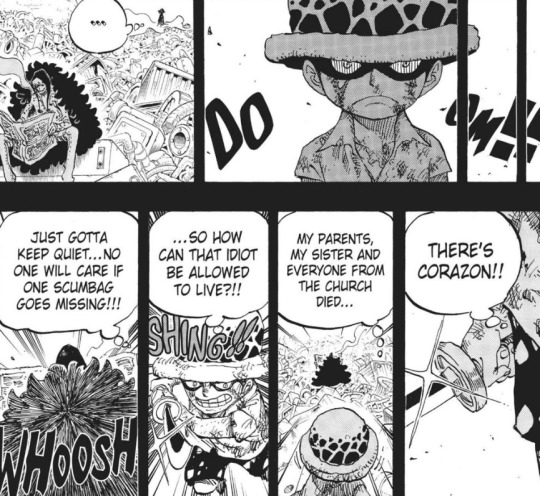
Corazon survives Law’s stabbing and doesn’t rat the little shit out (to Law’s confusion). It’s business as usual for another two years, then, one day Rosinante overhears his true name - Trafalgar “D” Water Law, and everything changes. On the back of his own beliefs, Rosinante dedicates himself to making sure Law a) lives and b) doesn’t become his brother. Law’s relatively short six month stint with Corasan forms the basis of Law’s new creed going forward, and all it took was a bit of kindness, love and humanity when the rest of the world had abandoned him. In the end Rosinante doesn’t save Law for the will of D. and the storm he’s predicted to bring in the future (as Law suspects), but he certainly believes in it, and the strength of Corasan’s conviction transfers right over to Law when he forces the ope ope fruit down the kid’s throat to heal him, tells Law he loves him, then sacrifices himself to set Law free.



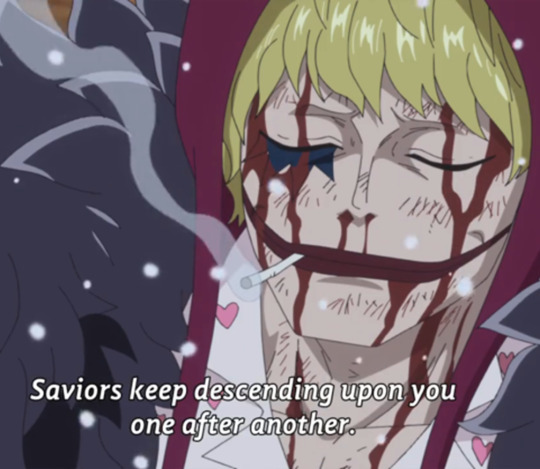
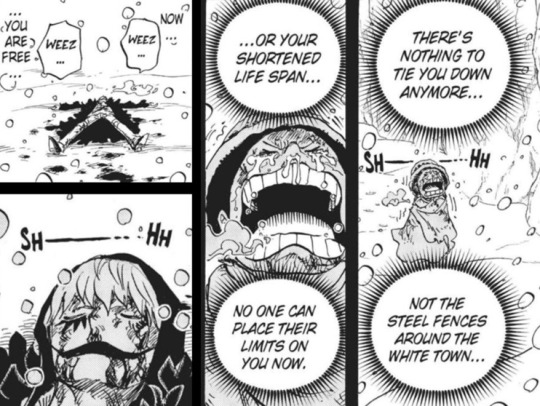
Law clings to that love he was given, he takes all these fundamental teachings and ways of thinking in regards to faith that were drilled into him during his youth, rejects the religion element and applies just about everything else to Corasan. He holds onto the last shreds of what Corasan leaves him with. Corasan becomes his “benefactor” (he gave my my heart), his saviour, his martyr.
And the crazy thing is, Rosinante was never really this saint Law makes him out to be. Law hated the clutz when they first met (mostly on account of Corazon throwing him through a glass window down at least two stories and into a pile of scrap). Corazon initially showed nothing but contempt for his presence (to ward him and the other children away from the Donquixote family, but these are still extreme measures). And it wasn’t until after learning Law’s name that Rosinante dragged him kicking, crying and screaming from hospital to burning hospital (not very saintlike in of itself), even after Law begged him to stop. Rosinante became Law’s saviour partly because of his belief in the will of D., and probably due to some guilt being a Donquixote, but mostly because he has always had a bleeding heart and he pitied (and had very quickly come to love) this angry, sick, deeply lost little kid. All this to say that Law’s faith in Corasan – this saintlike figure Law upholds him as in the future and the lengths he’s willing to go to avenge him/fulfil Rosinante’s purpose reflects the strength of the absolute beliefs Law would’ve been raised with in regards to God.
Whether it be out of survivor’s guilt (just one more body to heap on top of the Flevance pile), his love for Corasan, or for the sake of taking vengeance on the man that took away the one good thing he’d been able to regain in his miserable life, Law adopts Corasan’s will, the will of D. (which in of itself seems divine in nature), incorporates it into his new belief system, actively takes on the role of the divine punisher/justiciar and dedicates his life to bringing down Doflamingo.
3. Luffy
Catholicism dictates that the entirety of someone’s beliefs should be dedicated to one true cause (that cause being God) and expects people to ride on that, letting it carry them through life, give them hope, purpose, etc. But a lot of former Catholics choose instead to find that through something else. Corasan ignited the spark in Law’s faith around the will of D., but it’s not until he meets Luffy that this really becomes something that feels tangible and real for Law.
When Law saved Luffy in Marineford (putting the heart crew in danger for a stranger he met once), he said he did so “on a whim”, but that seems incredibly ooc for Law — this man that pretty much planned out how the rest of his life would go after the dust of Corasan’s death settled and he came to terms with the fact he wasn’t going to die at age thirteen like he’d originally thought. Circling back to the concept of Law being a sole survivor/messenger for God, it is interesting that Law is the one to seek out Luffy (given that Luffy is usually always the one either being abandoned by people or recruiting his crewmates), and Law is ultimately the catalyst for pulling him towards Dressrosa and Wano. There must be a REASON that led to Law deciding Luffy to be the most viable option out of the Worst Generation for an alliance (beyond blind trust in an unhinged captain that just so happens to also bear the initial D, and Luffy being one of the few captains crazy enough to go along with what Law was cooking up).
Law undoubtedly would’ve kept a peripheral eye on Luffy for some time before officially meeting him due to him being a rising competitor pirate and another “D” (I imagine the news of his utterly insane exploits would’ve made good reading material, too). The first time Law lays eyes on Luffy in Sabaody though, he still blows all expectations out of the water — crashing headfirst into the crowd of a slave auction and immediately committing a felony against a member of the most powerful upper one percent.
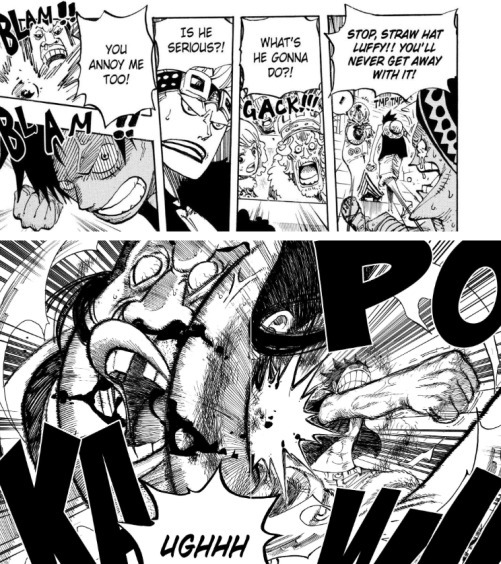

The world nobles are at an “untouchable God” tier in terms of class standing and believe it’s only natural for them to be entitled to whatever and whoever they want in this world that’s beneath them – the same kind of self-aggrandizing false divinity that Law has a a lot of repressed rage towards and that the will of D. is fated to oppose, so this, understandably, is a highly compelling first encounter, but it’s really only an initiating factor for what ultimately draws Law to Luffy. From their very first meeting (and probably before then, in the news stories and rumours Law likely picked up on), it’s made abundantly clear that Luffy does what he wants without a second’s hesitation, no matter the consequences, simply because he feels it is the right thing to do. Some call this an iron will, Law would be more inclined to call it willful stupidity and trouble, but time after time Luffy somehow manages to pull off what Law would best describe as “miracles”. And Law believes the straw hats just might be the ones to drum up another one for him.
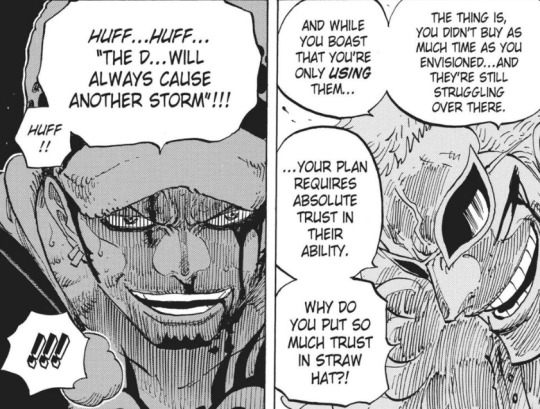
Luffy’s also got a lot of passing resemblances to Corasan going for him, e.g. inherently kind, compassionate liberators with big dumb hearts and wide goofy smiles in spite of everything they’ve been through, treating Law as nakama and saving his life despite his protests etc. All of which I’m sure Law hasn’t been completely unaffected by despite the high walls he puts up. And the more Law learned about Luffy the more it probably became clear that he is the antithesis to Doflamingo, i.e. what makes Luffy so goddamn dangerous and terrifying beyond his physical power is his ability to make friends with a simple kind of unconditional love that gets reciprocated enough so that these friends are willing to die for him.
Luffy agrees to the alliance, they successfully blow up Caesar’s base, and head off to Dressrosa. Now’s the time I should bring up that it’s taught in Catholicism that self sacrifice is the ultimate heavenly deed, and here Law is undoubtedly prepared to be a martyr for his cause. Law sends away his crew to Zou before Punk Hazard with the expectations that he’d never see them. He cultivates a fierce emotional detachment against Luffy’s willingness to bring him into the fold of the straw hats, and is resolute in that when the time comes, he will handle this himself, he will carry out Corasan’s will, and if he has to die for it, he will die with Corazon’s name plastered on his back. (Note here that Christianity is contradictory in that Law being this ready to die here is a sin, because revenge and suicide are highly discouraged, so you could say that by avenging and dying for his saviour, Law would be committing both the ultimate sacrifice and the ultimate sin).
Things get very dicey for Law in Dressrosa, to put it lightly. Doflamingo reveals that he was a celestial dragon (linking back into the will of D. “enemy of the Gods” notion), puts Law on the backfoot and gives him a thorough beating before shooting Law with a couple dozen white lead bullets in front of Luffy (because even when he’s winning Doffy loves to be a cunt about it). By the time Doflamingo is cuffing Law to the heart seat, it’s all looking pretty grim, and it’s very apparent when Luffy shows up to save him, that he is ready to die.

Law here has given up. He spent years planning his revenge for Corasan, but he lost, and he has very little left in the tank (physically, emotionally, spiritually). But Luffy doesn’t listen. Luffy who doesn’t think, doesn’t care, who trampled all over Law’s carefully laid out plan from the get-go and who is willing to take on Doflamingo single handedly for the simple slight that he dared to harm Luffy’s friend Law. Law will never find peace in his own demise because Luffy doesn’t do peaceful. He does loud and unashamed and open with no rhyme or reason other than the excruciatingly simply fact that he loves people and he thinks the people he loves deserve to have good lives. Luffy chucks Law over his shoulder and drags an injured Law across the city despite his protests (sound familiar?) and in the process inspires the fighting spirit in Law again.

When Law confronts Doflamingo again with Luffy in tow, Law’s faith in Luffy confounds him. The last Doflamingo remembers of Law is this beautifully moldable dark pit of grief and rage who’d given up on believing, period – who wanted the world destroyed. Not so long ago, Law had been a candidate for Doflamingo’s next protégé. Now?
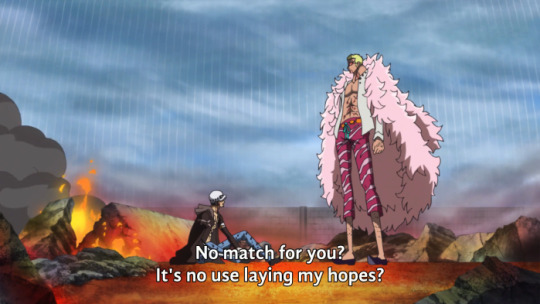
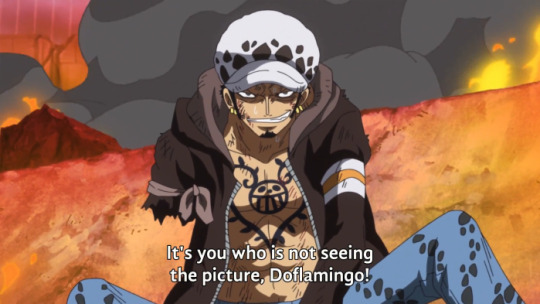

THIS is the action (grinning, staring down the barrel of a gun, flipping Doffy off as he tells him in not so many words that he may kill Law but he will never beat Luffy), Law’s unshakeable faith in the face of his own death is what has Doflamingo realising he will never regain control of Law again – is what incites Doflamingo to go from breaking Law down so he can build him back up again, to conceding defeat and outright killing him.
The trust that Luffy inspires in Law and the way he talks about Luffy (Luffy being this powerful, miracle-inducing liberator that Law can’t comprehend but follows anyway, Law laying down his hopes on him, weaponizing the will of D. to try and provoke fear from Doffy), is very reminiscent of the awe and faith talked about in scripture. Law discovers the feelings of comfort and hope that Catholicism was supposed to give him in Luffy, but Law’s belief in Luffy is a direct rejection of those teachings. Rejection by believing in a real life person as opposed to the divinity he was taught about. He’s also cementing his belief in the will of D., thus rejecting Doflamingo and all the people that embody the sort of “all powerful” divinity that he abhors (i.e. celestial dragons, Kaido, the Gorōsei/five elders) for the embodiment of hope and humanity.

When Law survives (again), he expresses he’d rather see Luffy beat Doflamingo with his own eyes or die with Luffy if he loses than leave. Then he watches, after all this talk of miracles, looking up in reverence as Luffy delivers, bright as the sun, haloed by the bars of a cage that’s haunted him for over a decade, Corasan’s words echoing at the back of his mind. God had never saved or freed Law, but Corasan was there for him, the heart crew was there, Luffy was there. And this is Law’s biggest, clearest rejection of religion – this newfound faith in humanity.
This faith in Luffy is put to the test again in Wano when Luffy is struck down by Kaido, but Law never truly stops believing that he’ll make a comeback. Even when the straw hats doubt whether he’s alive or not, something tells him Luffy’s not dead, and he holds onto that hope.
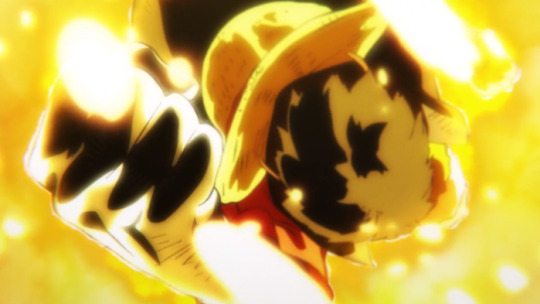


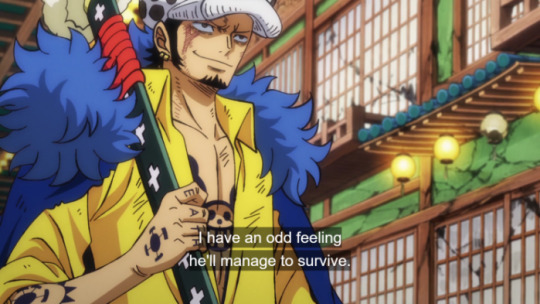
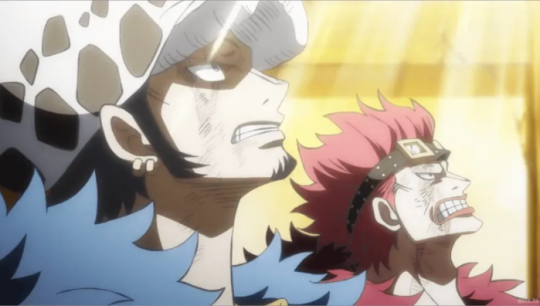
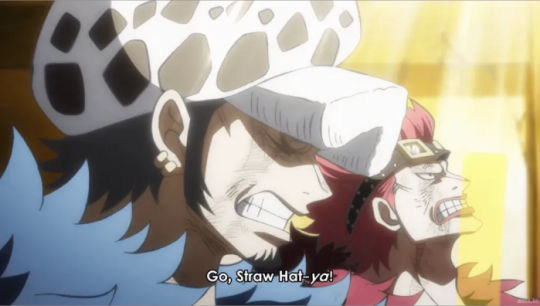
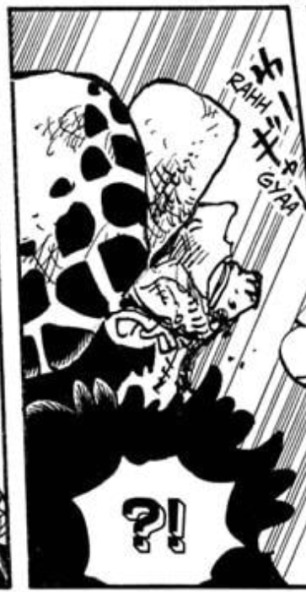

We also have the whole nika/joyboy backstory which really only reinforces all of this imagery/god-fearing looks of awe from Law and this idea of Luffy who is this perfect juxtaposition of empathetic and kind to incredibly fearsome fire and brimstone fighter. And regardless of whether you’re into the ship or not this is the impetus of Law’s relationship with Luffy for me, because here’s Luffy who has every right to have a chip on his shoulder and be downtrodden about all the injustices against him, here’s this little guy who against all odds, in the darkest of places, embodies light and hope and kindness and proves to Law that there will be hard times but there IS a happy ending at the end of the tunnel, despite it all. And everytime Luffy rises to the insurmountable challenge and wins, it just further cements that the will of D. is alive, that Corasan was right, that there's something redeemable in Law, a reason why he was worth saving, even if Law doesn’t understand it quite yet.
#merry christmas law religious trauma be upon ye#what’s an endearing idiot to a non-believer#long post#favourite character thesis statement. or something#ive been wanting to talk about this for a while but just been gathering my thoughts#will preface all this by saying I was not born or raised religious but the concept’s all very compelling from an outsider’s perspective#but I have had conversations about this to people like lesbianluffy who *were* raised catholic and relate to this experience#who I have to thank a lot for helping me wrap my head around this#this is a compilation of thoughts and conversations over the last two or so months#one piece#op#CJ's op watch-through#trafalgar law#monkey d. luffy#donquixote rosinante#donquixote corazon#monkey d luffy#lawlu#trafalgar d water law#gear 5 luffy#sun god nika#wano spoilers#lulaw#op meta#op analysis#one piece analysis
410 notes
·
View notes
Text
Week One hundred forty-nine, The Mercs As ...
DEAD US PRESIDENTS
Happy (American) Election Day, everyone
(Please pray for us)
(Suggestion credit: @randoidiot)
(Note: All portraits featured are from the White House Historical Association)









124 notes
·
View notes
Text
Trump Gears Up for Change on Wokeness With Education Overhaul
The president-elect has laid out big changes for America’s classrooms, including expanding school choice—and shutting down the Department of Ed
By Matt Barnum and Douglas Belkin -- Wall Street Journal
President-elect Donald Trump has vowed to remake education in the U.S., pledging to exert more control over funding and classroom lessons, to curb what he views as left-leaning tendencies at universities and even to dismantle the Department of Education.
If his White House delivers on those promises, more families could get money to send kids to private school. Schools would face pressure to limit accommodations for transgender students and to end some initiatives aimed at addressing racial disparities.
The goals are at once ambitious and controversial.
“There are a lot of very smart people who are very excited to get into positions where we can actually start making change happen,” said Tiffany Justice, a Trump ally and the co-founder of the conservative parents group Moms for Liberty.
Eliminating the Department of Education
Trump has promised to close the Education Department and has criticized U.S. school spending.
In his first term, he proposed merging the education and labor departments, but Congress didn’t proceed. It isn’t clear whether lawmakers would go for the idea in a second term, nor how the department’s functions—such as protecting students’ civil rights, providing funding for students with disabilities and distributing student loans—would be handled if it were closed.
Some Republicans have been reluctant to eliminate the department or cut federal funding that flows to schools in their constituencies. An Associated Press poll last year found that nearly two-thirds of Americans said the federal government spends too little on education.
“I don’t think you’ll see enormous cuts because that’s super unpopular,” said Michael Petrilli, president of the Thomas B. Fordham Institute, a conservative education think tank.
Trump will have to fill the education secretary role for now. Cabinet positions often go to prominent politicians and political allies.
Presidents sometimes look to state education chiefs. High-profile leaders in Republican states include Oklahoma’s Ryan Walters, who has fought culture-war battles in schools; Louisiana’s Cade Brumley, who has supported private-school choice and tougher school disciplinary measures; and Florida’s Manny Diaz Jr., who has overseen many conservative policy changes.
In an interview, Walters said he is focused on implementing Trump’s agenda in Oklahoma. Through a spokesperson, Brumley said “my focus is on continuing the historic educational progress we are making in Louisiana.” Diaz, through a spokesperson, said if asked to serve, “Of course you listen.” Justice of Moms for Liberty said that she would be open to the position, though hasn’t spoken to the Trump team about it.
A Trump transition spokeswoman didn’t comment on specific candidates.
Waging war on ‘woke’
Trump has said he would use the power of the purse to limit left-wing ideology in schools and universities.
Although a president can’t immediately cut off money to any school, he could use various laws to pressure schools to address antisemitism on campus, disband programs that focus on nonwhite student groups or reduce accommodations for transgender students.
Trump has said that he believes that Title IX, which bars sex discrimination in education, should prevent transgender girls from playing on female sports teams. This would be a stark reversal from the Biden administration, which has interpreted Title IX to prohibit discrimination based on gender identity.
During the campaign, Trump attacked Kamala Harris for being too supportive of transgender rights, an issue that resonated with some voters.
Trump has also indicated that he would use civil-rights law to challenge critical race theory, a term used by conservatives to describe some efforts to teach about racism and racial disparities. This could include targeting university diversity, equity and inclusion offices, legal analysts have said.
“On issues that I worry about…this is at the top,” said Rachel Perera, a fellow at the Brookings Institution, a center-left think tank.
Another tool Trump has at his disposal is the accreditation system, which gives universities access to federal money. He has called it a “secret weapon.”
Colleges and universities need to meet standards set by independent accreditors to be eligible for federal funds.
Trump could weaken the influence of accreditors—which he considers too left-leaning—by reassigning some of their responsibilities to the Education Department, said Judith Eaton, past president of the Council for Higher Education Accreditation. Alternatively, the administration could replace current accreditors with ones more closely aligned with Trump’s vision, she added.
Members of Trump’s inner circle “regard the higher-ed cartel as fundamentally out of order,” said Frederick Hess, director of education policy studies at the right-leaning American Enterprise Institute.
‘Universal school choice’
Trump wants “universal school choice for every American family,” according to his platform. That likely means providing a public subsidy for private-school tuition or other educational expenses outside the public school system.
Trump has indicated he would support the Educational Choice for Children Act, already proposed in Congress. The law would provide $10 billion in federal tax credits to go toward private-school tuition, home schooling or other educational costs.
Backers say the bill would provide money for up to two million children, and help parents direct and customize their children’s education. School-choice critics say that these programs drain resources from public schools.
Prior efforts by Republican presidents to subsidize private schools—including those supported by Ronald Reagan, and Trump in his first term—have failed to garner congressional support. And while many Republican-controlled state legislatures have adopted such programs in recent years, voters in Colorado, Kentucky and Nebraska rejected school-choice ballot measures on Nov. 5.
Some Republicans “are not fully on board yet,” said Jim Blew, who served as an education official during Trump’s first term. “I think they will be in the new administration.”
#Department of Education#Woke#trump#president trump#Democrats#love#trump 2024#art#repost#nature#america first#fashion#americans first#landscape#america#food#donald trump#lol#gif#diy#ivanka#instagram
133 notes
·
View notes
Note
I was telling someone about the white house renovation during the Truman years and how they completely gutted the interior structure using David McCullough's Truman biography as my primary source - do you have anything more specific about the white house renovations and the condition of the White House prior to its upgrade?
There was a GREAT website called whitehousemuseum.org with tons of awesome photos and history, but it sadly seems to have closed down a few months ago.
However, the White House Historical Association has a pretty solid website, too, and they frequently post in-depth stories and photos from their archives. Here's their section on the Truman Restoration -- I haven't gone through it thoroughly, but it looks like they have some really great photo galleries on there. And the WHHA usually has interesting related links on their stories, as well.
#White House#White House History#History#White House Historical Association#Harry S. Truman#President Truman#Truman Administration#Truman Restoration#White House Restoration
23 notes
·
View notes
Text

November, 1920 Florence Harding became the first future First Lady to vote for her husband in a presidential election, due to ratification of the Nineteenth Amendment less than three months earlier! From The White House Historical Association, FB.
71 notes
·
View notes
Text
A social worker turned interior designer is tackling furniture poverty by transforming the homes of social housing tenants through her charity.
Emily Wheeler, founder of Furnishing Futures, says the need for her charity is not just cosmetic design - domestic abuse survivors are often driven back to their perpetrators after being given empty social housing with no beds for their children.
When families escaping domestic violence are rehoused by their local council, properties are often stripped of all white goods, furniture, and flooring for health and safety reasons.
Having left their old homes suddenly without any of their belongings, families often end up in a flat or house with nowhere to cook or store food and no beds to sleep in, Emily Wheeler, founder of the charity Furnishing Futures, tells Sky News.
"There are no curtains at the windows, there's no oven, no fridge, no washing machine," she says. "Children are expected to sleep on concrete floors with no beds or bedding.
"Mothers may have experienced economic abuse or coercion and might not have access to their money and find themselves having to start again.
"So you can understand why some women think 'this is actually no better for my children than going back to my previous situation'."
Emily has been a frontline social worker in east London for more than 20 years. During a career break, during which she had her two children, she retrained as an interior designer.
When she returned to social work in 2014, she says austerity meant council budgets were being cut and previously available grants for social housing tenants were no longer funded.
"I've always seen furniture poverty throughout my career, but it had got worse," she says.
"I was meeting families living in these conditions without furniture and without access to support.
"When you look at the amount of stuff councils have to spend money on just to keep people safe, furniture isn't the priority."
Moved into empty flat two days after giving birth
Laura, not her real name, moved between different emergency accommodations while she was pregnant with her first child after being abused by her ex-partner.
She says she was offered a council flat two days after giving birth.
"When I first moved in it was all dirty, there was no furniture, no carpet, no cooker, fridge, or washing machine.
"I had to take out an emergency loan from Universal Credit to get away from my partner, so I didn't have any money left when my baby was born. The first couple of nights I could only eat takeaway food because there was nothing to cook with.
"It had concrete floors. I'd get up in the middle of the night to make my baby a bottle and it would be freezing, so I had to put blankets all over the floor."
Chief executive of the National Housing Federation Kate Henderson says: "In social housing, carpets have historically been removed as standard practice for practical reasons, to ensure hygiene between lets and to prevent any possible contamination.
"In some cases, housing associations provide new flooring as standard when a home is re-let, or in other cases they may provide decorating vouchers to new tenants, which can be used for flooring of their choice."
According to a 2021 study by the campaign group End Furniture Poverty, only 1% of social housing properties are furnished.
Councils under 'no legal obligation'
The Housing Act 1985 states that a local authority "may fit out, furnish and supply a house provided by them with all requisite furniture, fittings and conveniences".
But Emily says this means there is no legal obligation to do so.
"Councils are fulfilling their duty by providing housing, so in the eyes of the law they're not doing anything wrong.
"But having an empty shell of concrete is not a home - just because you're not on the streets."
Having seen the problem on a wider scale when she began chairing multi-agency child protection conferences, she decided to combine her skills as a designer and social worker - and create a charity to help bridge the gap.
Furnishing Futures was set up in 2019. Emily and her team refloor, paint, and furnish empty properties given to trauma and domestic abuse survivors by councils.
She uses her industry connections, which include Soho House, DFS, Dunelm, and others, to source donated furniture, and fundraises for the rest.
She believes it is the only charity of its kind in the UK.
So far they have furnished more than 80 homes across east London, and a pilot scheme with Waltham Forest council and housing association Peabody will see another three completed there.
But with thousands of families on social housing waiting lists in each of the capital's 32 boroughs alone, she wants to expand nationally.
"The hardest thing about my job is having to say no to people because we don't have the capacity," she says.
"Every day we get inquiries from women, midwives, health visitors, other local authorities, domestic abuse agencies - but we're just a small team and the demand is huge."
The charity has a 4,000-square-foot warehouse, a team of five full-time staff, and a group of regular volunteers who help with flooring, painting, and assembling furniture.
As situations are often urgent, work is usually done in just one day.
Empty homes are form of 'revictimisation'
Jen Cirone, director of services at Solace Women's Aid, one of the charity's partners, says being housed in an empty home and having to start again is a form of "revictimisation".
But she says of the charity: "It's not only the practicalities of having a beautiful space to live in but also demonstrates that others care.
"Together, Furnishing Futures is able to complete the road to recovery that work with Solace has put them on."
Hannah, not her real name, is another of Emily's clients.
She was homeless after leaving her ex-partner and given emergency accommodation a day before she was due to give birth to her first child.
"I felt extremely stressed and vulnerable," she says. "As a victim of domestic violence and heavily pregnant, I already felt alone and unsupported.
"This empty space didn't feel like 'home' and it certainly wasn't suitable for baby."
As a type one diabetic she also had nowhere to store her insulin injections, she adds.
"I ended up staying in hospital for some time due to an emergency C-section and during that time Emily turned my empty, scary space into a home for me and my child."
Emily says that although COVID and the cost-of-living crisis have opened the conversation about poverty and how it affects domestic abuse survivors, the situation is "worse than ever".
"We're not just talking about poverty now, we're talking about destitution," she says.
"People need safe and comfortable homes. You won't be able to recover from trauma, rebuild your life, and be a productive part of society if you don't have your basic needs met."
A Department for Levelling Up, Housing and Communities spokesperson said: "Domestic abuse survivors deserve a safe home and we are grateful to Furnishing Futures for the work they do to help these families rebuild their lives.
"We expect social housing providers to play their part and provide homes that are of a decent quality, if tenants are unhappy, we encourage them to speak to their landlords.
"Our Social Housing Regulation Act is also driving up standards and strengthened the role of the Ombudsman so that it is easier for tenants to raise complaints."
172 notes
·
View notes
Text
Just saw a Hilton ad that feels relevant to my post about landlords ripping up Victorian houses
A young woman is walking down an ornate staircase in a darkened old house, next to a wall of oil paintings, texting an apparently unresponsive AirBnB host in confusion
It then cuts to the same woman happily receiving towels from a smiling concierge in an all-white, brightly lit Hilton hallway
The framing here is fascinating and dismaying: the old house is dark, confusing, and associated by the text (“ghosted by your host?”) with the fear and discomfort of a haunting. By contrast, the hyper-modern and generic hotel is a bastion of safety and familiarity.
The message is clear- come to a modern hotel instead of a Creepy Old House That’s Probably Haunted! Why bother with the quirks and personality of a building outside the most baseline current design? Our featureless white walls invite no thoughts or opinions of your own!
Please ignore the fact that construction quality has tanked in recent years due to hyper-capitalist cost cutting, and you only have two minutes to escape from a building like this in a fire (while it offgases plastic fumes the whole time)!
I hate it here, architecturally-speaking
(Obviously there are very real issues with short-term vacation rentals. I just find the coding here interesting: they didn’t choose a modern house for the AirBnB, or a historical hotel for that segment)
108 notes
·
View notes
Text

Black Power vs. White Power: Why They’re Fundamentally Different (A Garveyite Perspective)
"A people without knowledge of their past history, origin, and culture is like a tree without roots." – Marcus Garvey
When uneducated people compare white power to Black power, it’s usually an attempt to dismiss the Black liberation movement or to paint both as equally harmful. This comparison couldn’t be further from the truth. From a Garveyite perspective, white power and Black power are opposites: one enforces oppression and domination, while the other is rooted in liberation and justice.
The false equivalence stems from ignorance about history, power structures, and the very different purposes behind these concepts. Here’s an in-depth breakdown of why white power and Black power are not the same, along with the historical and modern context of each, and examples of present-day Pan-African movements carrying forward Marcus Garvey’s vision.
White Power: A System Built on Oppression
White power is not just a phrase; it is a system. It has been embedded into global structures for centuries, designed to benefit white people at the expense of others. Its roots lie in the exploitation and domination of non-white people through systems like:
Colonialism: The plundering of Africa, Asia, and the Americas for resources and labour, paired with the erasure of native cultures.
The Transatlantic Slave Trade: The forced removal and enslavement of millions of Africans to build the wealth of Europe and the Americas.
Systemic Racism: Modern manifestations of white power include institutionalized racism in policing, housing, education, and healthcare.
White power exists to maintain dominance. It enforces hierarchies that privilege whiteness while dehumanizing and exploiting non-white populations. It thrives on exclusion, control, and violence.
Black Power: A Movement for Liberation
Black power emerged as a response to centuries of oppression. It is a movement rooted in survival, dignity, and self-determination. Black power is about:
Reclaiming Identity: Celebrating African heritage and resisting cultural erasure.
Self-Reliance: Building independent Black institutions and economies.
Unity: Strengthening solidarity among African-descended people worldwide to fight against systemic oppression.
Unlike white power, Black power doesn’t seek to dominate or oppress others. It seeks freedom, equity, and justice. It’s about dismantling systems of exploitation and creating opportunities for Black people to thrive.
Why They’re Not the Same: Key Differences
1. Historical Context and Intent
White Power: Rooted in colonization, slavery, and global domination. Its intent is to control, exploit, and suppress.
Black Power: Rooted in resistance to oppression. Its intent is to liberate and empower.
2. Power Structures
White Power: Maintains and enforces hierarchical systems that privilege whiteness. Examples include Jim Crow laws, apartheid, and voter suppression.
Black Power: Seeks to dismantle these systems and create equality. Movements like Garvey’s Universal Negro Improvement Association (UNIA) emphasized self-determination and freedom from white dominance.
3. Economic Foundations
White Power: Built on exploitation—slavery, colonialism, and the extraction of resources from African nations.
Black Power: Focused on empowerment through self-reliance and economic independence. Garvey’s Black Star Line was a prime example of creating Black-owned infrastructure.
4. Cultural Impact
White Power: Enforces cultural erasure and assimilation. For example, Indigenous languages, African spiritual practices, and traditions were systematically destroyed.
Black Power: Revives and celebrates African culture, from Afrocentrism to the global embrace of Black art, music, and fashion.
5. Use of Violence
White Power: Systematically uses violence to enforce control (e.g., lynching, rape, genocide, police brutality, military invasions).
Black Power: Advocates for self-defense and survival against white violence but does not seek to harm or dominate others.
6. Psychological Effects
White Power: Creates internalized racism, generational trauma, and systems of dehumanization.
Black Power: Focuses on healing, self-love, and rebuilding the collective identity of African-descended people.
A Garveyite Perspective: Why Black Power Matters
From Marcus Garvey’s perspective, Black power is not just about resistance; it’s about building a new world for Black people. Garvey’s vision for Black liberation included:
Global Black Unity: Connecting African-descended people worldwide to work toward shared liberation.
Self-Reliance: Encouraging Black people to build their own businesses, schools, and governments rather than relying on systems built to oppress them.
Reclaiming Africa: Garvey believed in a liberated Africa as a central hub for Black self-determination.
Garvey’s dream was echoed by later leaders like Kwame Nkrumah, Malcolm X, and Patrice Lumumba. Their work laid the foundation for modern Pan-African movements.
The False Equivalence: A Harmful Misunderstanding
When people equate white power with Black power, they ignore the power dynamics that define these terms. White power has always been about domination, while Black power is about freedom from that domination. To say they are the same is to erase history and perpetuate the very systems of oppression that Black power seeks to dismantle.
Conclusion: Liberation, Not Supremacy
White power and Black power are fundamentally different in intent, history, and purpose. White power thrives on exploitation, hierarchy, and exclusion. Black power is about liberation, justice, and reclaiming dignity.
As Marcus Garvey said:
"Up, you mighty race, accomplish what you will!"
Black power is not about oppressing others; it’s about undoing centuries of oppression and building a world where Black people can thrive on their own terms. Garvey’s legacy reminds us that this fight isn’t just historical—it’s ongoing. The question remains: What are you doing to contribute to the liberation of Black people globally?
#black people#black history#black#blacktumblr#pan africanism#black conscious#africa#black power#white power#white people#white privilege#marcus garvey#black tumblr#white supremisist#white supremacy#colonialism#systemic racism#african unity#black community#black liberation#black excellence#black diaspora#african diaspora
27 notes
·
View notes
Text
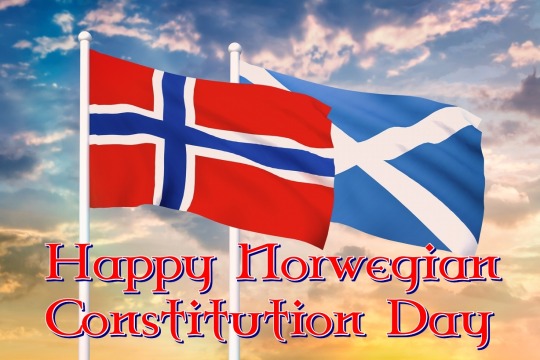
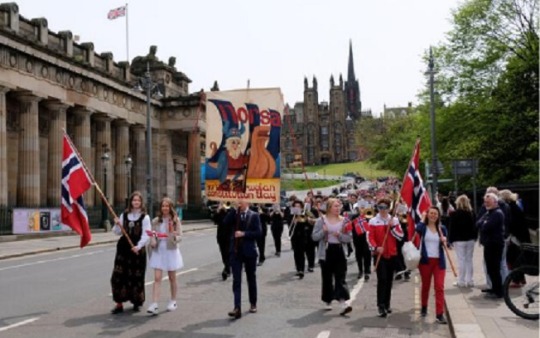
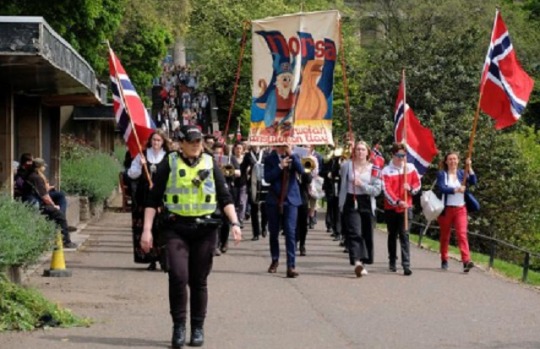
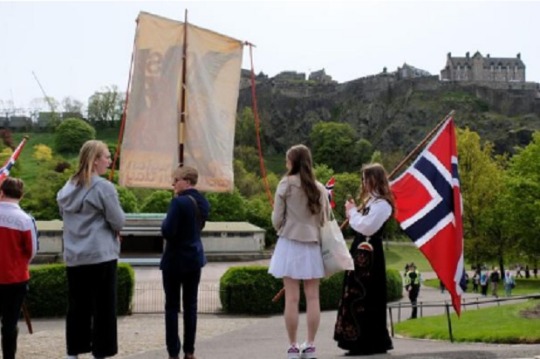
May 17th is Norwegian Constitution Day or Syttende Mai as its known in Norway.
A wonderful spring holiday celebrated with red, white and blue ribbons, national costumes and waving of the Norwegian flag, the three colours are everywhere in Norway at this time of year.
It’s a day Norwegians all over the world take off to celebrate and marks the historic signing of the Constitution in 1814, the year Norway gained its independence from Sweden, which was fully realized in 1905.
In every city, town and village in Norway, children and adults alike express their cultural pride by marching to the bright music of school bands, celebrating the joy of springtime and honoring of those citizens who created Norway’s constitutional government, founding her independence.
Especially popular is the Children’s Procession that brings every child out in their best clothes or national costume.
In Edinburgh the Norwegian community celebrate Syttende Mai too.
Edinburgh’s celebrations include the Norwegian Scottish Society dinner, after a reception at the Norwegian Consulate’s residence.
Each year Norwegian students in Edinburgh hold a breakfast at Prestonfield House followed by a parade along Waterloo Place and onto Princes Street. At the boom of Edinburgh Castle’s One o’ clock gun, the pigeons fly and the parade begins!
Tonight expats and guests gather at The Royal Scots Club Abercromby Place for a celebration dinner held by the Norwegian Scottish Association. The association was founded in Edinburgh in 1966, and has enjoyed over 50 years of Norwegian-Scottish friendship.
Norwegian Scottish Association roots lie in a much older friendly society, one rooted in the shared experience of Norwegians and Scots during the Second World War. Founded in Dumfries in 1941, the Scottish Norwegian Society brought Scots and Norwegians together in difficult times. Having escaped the German occupation of their homeland in 1940, around a thousand Norwegians had come to be stationed at various times in Dumfries, and it was not long before the idea of a formal society was begun.
Of course our history with Norway goes back centuries, Northern Scotland, was, at one time, a Norse domain and the Northern Isles experienced the most long-lasting Norse influence. Almost half of the people on Shetland today have Viking ancestry, and around 30% of Orkney residents.
Many agree that there are many points of commonality between the Norse character and the Scottish one that leads to a sense of kinship between the two countries, even for those living much further south in Scotland, where Viking influence did not reach. Words like bairn and muckle made their way into Scot’s language via the Norwegians.
I touched upon the links during the second world war earlier and have posted before about the Shetland bus which provided a transport link between the Shetland Islands and occupied Norway. Many Norwegian refugees fled their occupied home with the help of Norwegian sailors who undertook daring, high-risk trips across the North Sea. The whole episode became emblematic of the friendship across the seas.
More recently Edinburgh’s Zoo also has a strong connection to Norway as it is home to a very special resident. Sir Nils Olav III is the mascot and colonel-in-chief of the Norwegian King’s Guard. The king penguin’s rank has been passed down through three generations since 1972. Knighted in 2008, he even received a military promotion in 2016 with the brigadier title bestowed upon him in a special ceremony at the zoo.
The Zoo’s link with Norway originated in 1913 when arctic explorer Roald Amundsen presented a penguin to them on their opening. Once a year the penguin inspects soldiers from Norway’s King’s Guard.
Edinburgh's Syttende mai parade – the 17th May or Norwegian Constitution Day parade traditionally takes place along the capital's main thoroughfare, Princes Street. At the boom of Edinburgh Castle's 'one o' clock gun', the pigeons fly and the parade begins!
Pics are from last ears parade.
72 notes
·
View notes